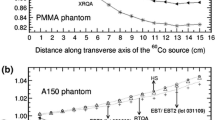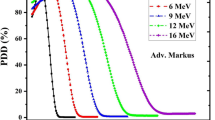Abstract
In the present study, beam quality correction, \(k_{{Q,Q_{0} }} (r)\), and phantom scatter correction, kphan(r), for low-energy brachytherapy sources, 131Cs, 125I, and 103Pd, are calculated using the Monte Carlo-based EGSnrc code system as a function of the distance along the transverse axis of the source. The solid-state detectors investigated are diamond, LiF, Li2B4O7, Al2O3, and radiochromic films, such as HS, EBT, EBT2, EBT3, RTQA, XRT, and XRQA. The solid phantoms investigated are polystyrene, PMMA, virtual water, solid water, plastic water (LR), A150, RW1, RW3, and WE210. For a given detector and brachytherapy source, \(k_{{Q,Q_{0} }} (r)\) is independent of distance in the water phantom. Meanwhile, for a given detector, kphan(r) depends on the distance from the source for the investigated solid phantoms. Moreover, the kphan(r) values do not change with the detector type for sources 131Cs, 125I, and 103Pd at all distances. The LR and A150 phantoms are water equivalent for the investigated distances of 1–5 cm. The phantoms including solid water, virtual water, and WE210 are not water-equivalent for distances beyond 1 cm. Furthermore, PMMA, polystyrene, RW1, and RW3 are not water equivalent.






Similar content being viewed by others
References
Crook J. The role of brachytherapy in the definitive management of prostate cancer. Cancer/Radiotherapie. 2011;15:230–7.
Keller B, Sankreacha R, Rakovitch E, O’Brien P, Pignol J. A permanent breast seed implant as partial breast radiation therapy for early-stage patients: a comparison of palladium-103 and iodine-125 isotopes based on radiation safety considerations. Int J Radiat Oncol Biol Phys. 2005;62:358–65.
Beaulieu L, Tedgren AC, Carrier J, Davis SD, Mourtada F, Rivard MJ, Thomson RM, Verhaegen F, Wareing TA, Williamson JF. Report of the Task Group 186 on model-based dose calculation methods in brachytherapy beyond the TG-43 formalism: current status and recommendations for clinical implementation. Med Phys. 2012;39:6208–36.
Butson MJ, Yu PN, Cheung T, Metcalfe P. Radiochromic film for medical radiation dosimetry. Mater Sci Eng. 2003;41:61–120.
DeWerd LA, Liang Q, Reed JL, Culberson W. The use of TLDs in brachytherapy dosimetry. Radiat Meas. 2014;71:276–81.
Surendra NR. Application of a diamond detector to brachytherapy dosimetry. Phys Med Biol. 1998;43:2085–94.
McLaughlin WL. Novel radiochromic films for clinical dosimetry. Radiat Prot Dosim. 1996;66:263–8.
Muench PJ, Meigooni AS, Nath R, McLaughlin WL. Photon energy dependence of the sensitivity of radiochromic film and comparison with silver halide film and LiF TLDs used for brachytherapy dosimetry. Med Phys. 1991;18:769–75.
Azam N, Blackwell CR, Coursey BM, et al. Radiochromic film dosimetry: Recommendations of AAPM Radiation Therapy Committee Task Group 55. Med Phys. 1998;25:2093–115.
Butson MJ, Cheung T, Yu PK. Radiochromic film: the new x-ray dosimetry and imaging tool. Australas Phys Eng Sci Med. 2004;27:230.
Davis SD, Ross CK, Mobit PN, Van der Zwan L, Chase WJ, Shortt KR. The response of LiF thermoluminescence dosemeters to photon beams in the energy range from 30 kV X rays to 60Co gamma rays. Radiat Prot Dosim. 2003;106:33–43.
Ebert M, Asad A, Siddiqui A. Suitability of radiochromic films for dosimetry of low energy X-rays. J Appl Clin Med Phys. 2009;10:232–40.
Chiu-Tsao ST, Ho Y, Shankar R, Wang L, Harrison LB. Energy dependence of response of new high sensitivity radiochromic films for megavoltage and kilovoltage radiation energies. Med Phys. 2005;32:3350–4.
Meigooni AS, Meli JA, Nath R. Influence of the variation of energy spectra with depth in the dosimetry of 192Ir using LiF TLD. Phys Med Biol. 1988;33:1159–70.
Pradhan AS, Quast U. In-phantom response of LiF TLD-100 for dosimetry of 192Ir HDR source. Med Phys. 2000;27:1025–9.
Pradhan AS. A concern on in-phantom photon energy response of luminescence dosimeters for clinical applications. J Med Phys. 2010;35:187–8.
Subhalaxmi M, Palani ST. Monte Carlo-based investigation of absorbed-dose energy dependence of radiochromic films in high energy brachytherapy dosimetry. J Appl Clin Med Phys. 2014;15:351–62.
Palani Selvam T, Subhalaxmi M, Vishwakarma RS. Monte Carlo calculation of beam quality correction for solid-state detectors and phantom scatter correction at 137Cs energy. J Appl Clin Med Phys. 2014;15:339–50.
Subhalaxmi M, Palani ST. Monte Carlo-based beam quality and phantom scatter corrections for solid-state detectors in 60Co and 192Ir brachytherapy dosimetry. J Appl Clin Med Phys. 2014;15:295–305.
Subhalaxmi M, Palani ST. Monte Carlo calculation of beam quality and phantom scatter corrections of lithium formate Electron Paramagnetic Resonance dosimeter for high energy brachytherapy dosimetry. J Med Phys. 2017;42:72–9.
Nath R, Anderson LL, Luxton G, Weaver KA, Williamson JF, Meigooni AS. Dosimetry of interstitial brachytherapy sources: recommendations of the AAPM Radiation Therapy Committee Task Group No. 43. Med Phys. 1995;22:209–34.
Rivard MJ, Coursey BM, De Werd LA, et al. Update of AAPM Task Group No. 43 Report: a revised AAPM protocol for brachytherapy dose calculations. Med Phys. 2004;31:633–74.
Meli JA, Meigooni AS, Nath R. On the choice of phantom material for the dosimetry of 192Ir sources. Int J Radiat Oncol Biol Phys. 1988;14:587–94.
Williamson JF. Comparison of measured and calculated dose rates in water near I-125 and Ir-192 seeds. Med Phys. 1991;18:776–86.
Ballester F, Puchades V, Lluch JL, Serrano-Andrés MA, Limami Y, Pérez-Calatayud J, Casal EA. Technical note: Monte-Carlo dosimetry of the HDR 12i and Plus 192Ir sources. Med Phys. 2001;28:2586–91.
Song H, Chen Z, Yue N, Wu Q, Yin FF. Ice as a water-equivalent solid medium for brachytherapy dosimetric measurements. Radiat Environ Biophys. 2009;48:145–51.
Tedgren AC, Carlsson GA, Schoenfeld AA, Harder D, Poppe B, Chofor N. Influence of phantom material and dimensions on experimental 192Ir brachytherapy dosimetry. Med Phys. 2009;36:2228–35.
Schoenfeld AA, Harder D, Poppe B, Chofor N. Water equivalent phantom materials for 192Ir brachytherapy. Phys Med Biol. 2015;60:9403–20.
Schoenfeld AA, Thieben M, Harder D, Poppe B, Chofor N. Evaluation of water-mimicking solid phantom materials for use in HDR and LDR brachytherapy dosimetry. Phys Med Biol. 2017;2:N561–572.
Meigooni AS, Meli JA, Nath R. A comparison of solid phantoms with water for dosimetrty of 125I brachytherapy sources. Med Phys. 1988;15:695–701.
Reniers B, Verhaegen F, Vynckier S. The radial dose function of low-energy brachytherapy seeds in different solid phantoms: comparison between calculations with the EGSnrc and MCNP4C Monte Carlo codes and measurements. Phys Med Biol. 2004;49:1569–82.
Subhalaxmi M, Palani ST. Phantom scatter corrections of radiochromic films in high energy brachytherapy dosimetry: a Monte Carlo study. Radiol Phys Tecnol. 2015;8:215–23.
Kawrakow I, Mainegra-Hing E, Rogers DWO, Tessier F, Walters BRB. The EGSnrc Code System: Monte Carlo simulation of electron and photon transport. NRCC Report PIRS–701. Ottawa, ON: National Research Council of Canada. 2010. https://www.irs.inms.nrc.ca/EGSnrc/pirs701.pdf. Accessed 10 Feb 2016.
Karaiskos P, Papagiannis P, Sakelliou L, Anagnostopoulos G, Baltas D. Monte Carlo dosimetry of the selectSeed 125I interstitial brachytherapy seed. Med Phys. 2001;28:1753–60.
Sadeghi M, Hosseinib SH, Raisali G. Experimental measurements and Monte Carlo calculations of dosimetric parameters of the IRA1-103Pd brachytherapy source. Appl Radia Isot. 2008;66:1431–7.
Rivard MJ. Brachytherapy dosimetry parameters calculated for a 131Cs source. Med Phys. 2007;34:754–62.
NUDAT 2.0, National Nuclear Data Center, Brookhaven National Laboratory. https://www.nndc.bnl.gov/nudat2/index.jsp. Accessed 18 Jan 2020.
Murphy MK, Piper RK, Greenwood LR, Mitch MG, Lamperti PJ, Seltzer SM, Bales MJ, Phillips MH. Evaluation of the new cesium-131 seed for use in low-energy x-ray brachytherapy. Med Phys. 2004;31:1529–38.
Seco J, Evans PM. Assessing the effect of electron density in photon dose calculations. Med Phys. 2006;33:540–52.
Mobit PN, Mayles P, Nahum AE. Quality-dependence of LiF TLD in megavoltage photon beams: Monte Carlo simulation and experiments. Phys Med Biol. 1996;41:387–98.
Mobit PN, Nahum AE, Mayles P. A Monte Carlo study of the quality dependence factors of common TLD materials in photon and electron beams. Phys Med Biol. 1998;43:2015–32.
Carl JM, Claus EA, Marianne CA, Bøtter-Jensen L. Optical fibre dosemeter systems for clinical applications based on radioluminescence and optically stimulated luminescence from Al2O3:C. Rad Prot Dos. 2006;120:28–322.
Kaveckyte V, Malusek A, Benmakhlouf H, Tedgren CAC. Suitability of microDiamond detectors for the determination of absorbed dose to water around high-dose-rate 192Ir brachytherapy sources. Med Phys. 2018;45:1170–82.
Rogers DWO, Kawrakow I, Seuntjens JP, Walters BRB, Mainegra-Hing E. NRC User Codes for EGSnrc. NRCC Report PIRS-702 (revB). Ottawa, ON: National Research Council of Canada. 2010. https://www.irs.inms.nrc.ca/EGSnrc/pirs702.pdf. Accessed 10 Feb 2016.
Hubbell JH, Seltzer SM. Tables of x-ray mass attenuation coefficients and mass energy-absorption coefficients, National Institute of Standards and Technology, Gaithersburg, MD. 1995. https://physics.nist.gov/PhysRefData/XrayMassCoef. Accessed 22 Feb 2017.
Selvam TP, Biju K. Monte Carlo investigation of energy response of various detector materials in 125I and 169Yb brachytherapy dosimetry. J Appl Clin Med Phys. 2010;11:1170–82.
Chamberland M, Taylor REP, Rogers DWO, Thomson RM. egs_brachy: a versatile and fast Monte Carlo code for brachytherapy. Phys Med Biol. 2016;61:8214–31.
Berger MJ, Hubbell JH. XCOM, Photon cross sections on a personal computer. Report No. NBSIR87–3597. Gaithersburg, MD: NIST. 1987.
Acknowledgements
Authors wish to thank Dr. B. K. Sapra, Head, Radiological Physics and Advisory Division, Bhabha Atomic Research Centre, Mumbai, for her encouragement and support throughout the studies.
Funding
No funding is received for this study.
Author information
Authors and Affiliations
Corresponding author
Ethics declarations
Conflict of interest
The authors report no conflict of interest.
Ethical approval
This article does not contain any studies with human participants or animals performed by any of the authors.
Additional information
Publisher's Note
Springer Nature remains neutral with regard to jurisdictional claims in published maps and institutional affiliations.
About this article
Cite this article
Mishra, S., Selvam, T.P. EGSnrc-based depth-dependent photon energy response and phantom scatter corrections for low-energy brachytherapy sources. Radiol Phys Technol 13, 256–267 (2020). https://doi.org/10.1007/s12194-020-00578-z
Received:
Revised:
Accepted:
Published:
Issue Date:
DOI: https://doi.org/10.1007/s12194-020-00578-z




